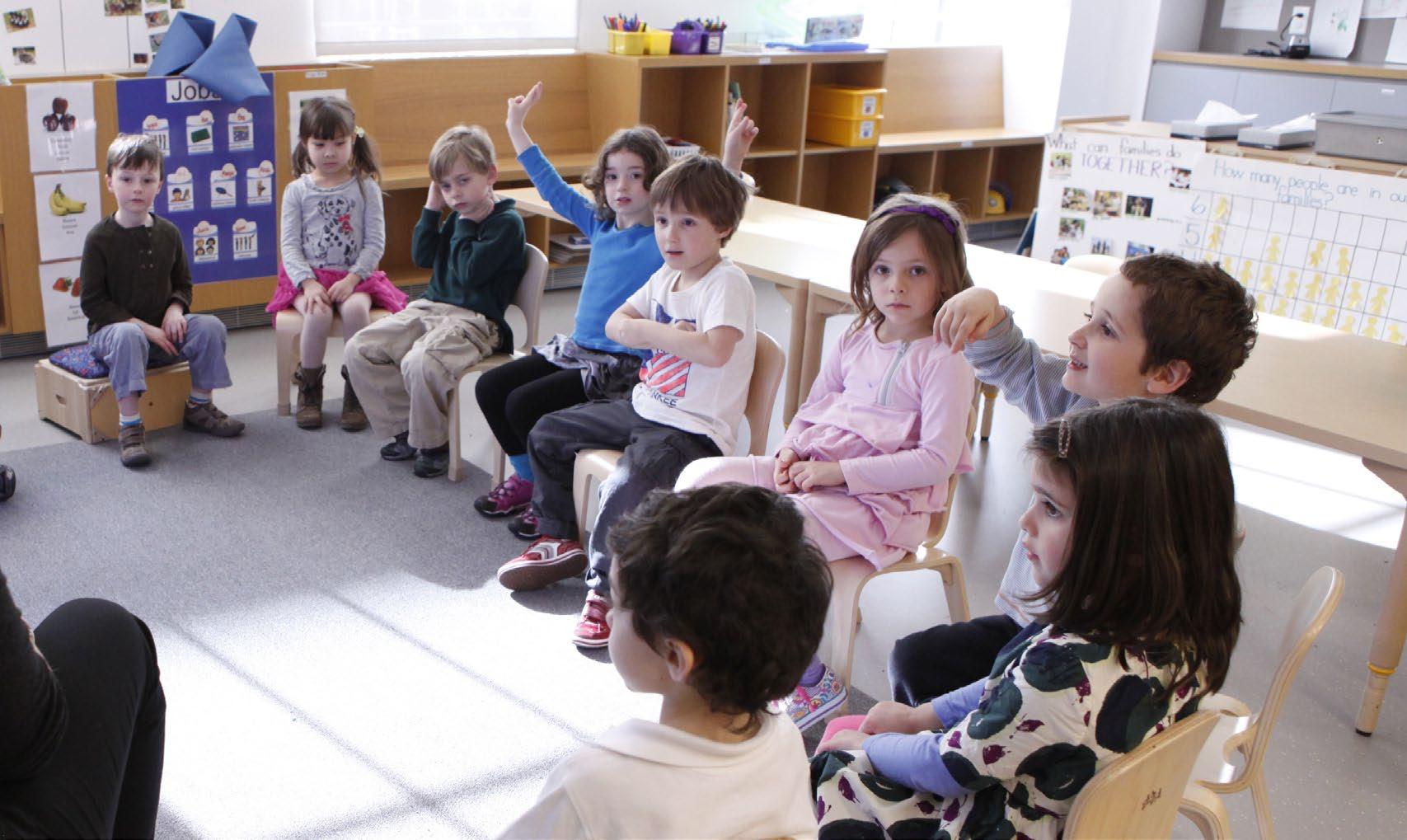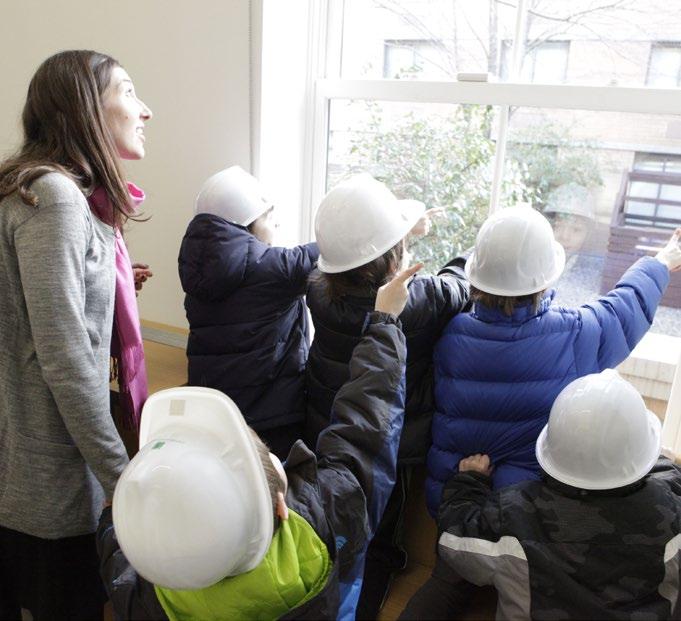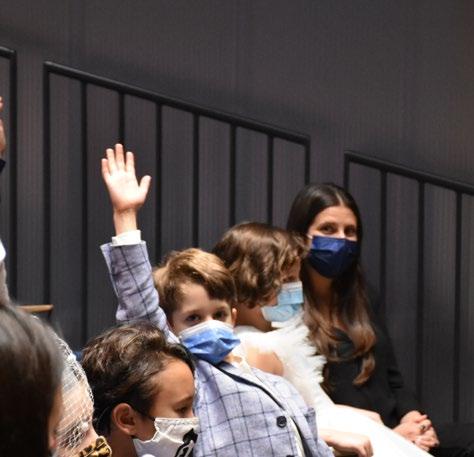
15 minute read
EC 10 YEAR ANNIVERSARY
Many of Gaynor’s signature spaces and programs are the realizations of Co-Founder and Director of Education Yvette Siegel-Herzog’s dreams. The founding of the school itself in 1962 was a dream Yvette shared with Dr. Miriam Michael, her Co-Founder. The recent completion of the Performing Arts Center was another of those dreams, but one of her visions brought to life over a decade ago is now so integral to the life of the school that it is hard to imagine Stephen Gaynor School without it.
The Early Childhood (EC) Program is a unique and innovative model of early intervention for students with learning differences, ages three to six. It combines traditional early childhood experiences with the most effective methods in special education to help children mitigate learning challenges, make great strides in their educational, social, physical, and emotional development, and put them on the path to sustained academic success.
This year marks the 10th anniversary of Gaynor’s Early Childhood Program, and we sat down with Director of Early Childhood Rebecca Jurow, Director of Lower Division Donna Logue, and Speech and Language Department Chair Jen Cohen. All three were key players in bringing Yvette’s vision to life. Ms. Logue remembered, “Yvette’s dream was to open up an early childhood program so that we could reach children before they experienced the learning failure that we see at Stephen Gaynor School. She wanted to know if I would be interested in running the program.”
While she knew she was skilled at envisioning new programs, and making them run smoothly, Ms. Logue felt strongly that the school needed skilled early childhood educators to ensure this new venture would be successful in the long term. Still, she said, “When Yvette Siegel asks you to do something with her, why wouldn't you do that, right? You know, when a genius asks you to start something from scratch, of course you take them up on that.”
Ms. Siegel also already had the conceptualization that therapies would need to be a key component of the Early Childhood Program, and speech and language therapy would be the core of the therapy program. It was at this point that Jen Cohen entered the picture.
According to Ms. Cohen, “Yvette and Donna called me, and I came in for an interview. I spent a little bit of time in the class, and then Donna and I sat and spoke, and it was a match made in heaven.”

Ms. Logue agreed. “I say it was kismet. I saw in Jen someone who I knew understood young children, and who I knew understood what Gaynor was about. She had both of those pieces right away, and I felt like she was someone who could really partner with me, and that gut instinct from that meeting served to be very, very true. I could not have done anything without Jen. And then Jen was the one who recommended Rebecca.”
According to Ms. Cohen, she and Ms. Jurow had worked together for years, and when this initiative began, Ms. Cohen immediately thought of her. Ms. Jurow came in to meet with Ms. Logue for an interview, and Ms. Logue said, “It was a three-hour interview. We both cried.”
“I saw in Rebecca someone who could run the program, and who also understood Gaynor,” Ms. Logue said. “Bringing in people from the outside of Gaynor was a risk because, as you know, Gaynor is a special place. We do things in a particular way, so a lot of my role was helping [the outside early childhood experts] to understand the Gaynor methodology, and what a Gaynor student would look like in the Pink Cluster, in the Intermediate Division, and ultimately in the Blue Cluster.” Ms. Jurow with one of the very first Early Childhood classes. Lana Edelman, now Gaynor's Educational Evaluator for Admissions, touring the future EC space with a group of budding architects.


The program was originally conceived as a standalone program; the students in Early Childhood would not automatically be granted admission to Gaynor. However, the founders of the EC learned early on that the students they accepted to the program needed the skills and strategies a Gaynor education provides for longer than just the EC years.
“I think that what I've discovered is that a lot of the children that we accepted in Early Childhood would need explicit step-by-step multisensory instruction and strategies for a long time,” said Ms. Logue. “Gaynor’s never been about just learning how to read. It's always been about learning how to learn. That takes a lot of time.”
At the time that the Early Childhood Program was in the conceptual stage, Head of School Dr. Scott Gaynor and Ms. Logue were scouting for locations for the program. They looked at many options, but none of them seemed to be the right fit. “I remember I was so sad at the thought that I was not going to be physically present at Stephen Gaynor School; that by taking on this job, I wouldn’t be in the life of Gaynor, and I wouldn’t see Yvette,” Ms. Logue said.
But Dr. Gaynor had a surprise in store for Ms. Logue when she returned from Winter Break in 2010. That January, unbeknownst to Ms. Logue at the time, Stephen Gaynor School had purchased the former Claremont Stables building, which was next to what is now known as the North Building. Acquiring the building added more than 65,000 square feet of new space adjacent to the existing location — a truly remarkable opportunity given the limitations of Manhattan real estate. In a 2010 Gazette article announcing the development, Trustee Carol Feinberg was thanked for her leadership in the effort to acquire the stables. At that time, she remarked, “The purchase of the historic Claremont Riding Academy is a monumental move forward for Stephen Gaynor School.”
“I remember coming back from Winter Break the year we purchased the building, and Scott saying, ‘Come, I want to show you something. We found a place for your Early Childhood Program,’” said Ms. Logue. “He took me up to the OT Room in the North Building, and he pointed out the window, and he said, ‘Your Early Childhood Program is going to be there.’ And it took a while for it to sink in. I’m like, you mean in the horse stables?”
He confirmed that it was indeed the horse stables, and that now Ms. Logue and the team would need to figure out what to do with the space. Ms. Logue remembered, “I thought two things: one, thank goodness the [previous owners] had cleaned out all the manure, and two, I wasn't going to have to be away from
my home. We were really going to be part of Gaynor. And that was so wonderful. I am very grateful to the board members who had the vision and the courage to do the fundraising for the program.”
The physical location of the Early Childhood Program is hugely important, according to Ms. Logue. “There's that continuity of Gaynor that we wouldn't have necessarily if we were physically separated, and I am also grateful for the generosity that Scott had in terms of time and other resources, and soliciting our feedback about what the ideal space would look like.”
She continued, “Scott really had that architectural vision, and he could really imagine the spaces, and he could really interpret what we were saying.” Every member of the team was investing in getting the spaces right. According to Ms. Logue, “The leadership made us confident that our ideas were important, and that we needed to dig a little bit deeper to make those spaces as ideal as we could possibly get them.”
Ms. Jurow agreed with Ms. Logue, and said, “It's funny that you say that, because I was thinking that your conversations with me made me feel that my opinion mattered, which was really incredibly generous.”
According to Ms. Logue, the blank slate the Claremont Stables provided allowed the physical space and the program to become inextricably intertwined. “The environment helps to shape the behavior and the program,” she said. “You know, before you change the kid, change the environment and see if that will [make a difference]. So we were really dedicated to creating the best physical spaces that we could.”
When asked if the EC of today is what they might have pictured ten years ago, Ms. Logue said, “By and large, it's what I expected. I think the thing that I didn't expect was how successful we were in identifying kids who would eventually be labeled dyslexic. Or have some kind of similar learning disability. I didn't anticipate that we were catching them, we were really catching them.”
Today’s Early Childhood Program is unique among EC programs in New York City. Everything children see, hear, and do in the EC – from manipulating blocks and drawing pictures to listening quietly during story time – helps them become confident, independent learners. In a comfortable and enriching environment, children learn to follow directions, work together with their peers, and participate in exciting hands-on activities.
Ms. Jurow explained the Gaynor difference by saying, “Nobody else has the level of push-in and pull-out support with occupational therapy and speech therapy. We also have [extremely qualified] teachers teaching in preschool, and that often doesn't happen.”
As with the Lower, Intermediate, and Upper Divisions, the EC offers an individualized curriculum that allows students to work at their own pace, while still providing academic challenges. Students have a full team of professionals — occupational therapists, speech-language pathologists, and classroom teachers — who work daily to address individual student needs.
The faculty and specialists in the Early Childhood Program provide comprehensive support for their students, and they are always looking for ways to unlock each child’s
Ms. Jurow and an EC student engrossed in a good book. Then Assistant Teacher Nick Felt and Head Teacher Mary-Sutton Gonzalez brought the students from the original Willow, Casco, and Caraway EC Classrooms to tour the new spaces. All of the classrooms were named for horses who lived in the Claremont Stables.

Dr. Scott Gaynor, Yvette SiegelHerzog, Dr. Miram Michael, and Trustee Carol Feinberg at the ribbon cutting ceremony for the South Building.

potential. According to Ms. Logue, “A child might have very low language, but with the right kind of language support like we provide at Gaynor, that language might come and explode, and then you're going to see intellectually a different kid.”
But sometimes that language does not come so easily, and in that case, the EC team looks for other ways for them to show what they know. When the team gets together to work with a child who might be a good fit for Gaynor, they are primarily looking to see if the child responds to Gaynor’s positive behavioral approach.
Ms. Logue said, “That was always the biggest piece for me, is whether I could make a connection with a kid. And through that connection, would the child give me their best effort?”
Finding that “just right” fit takes a lot of effort, and parents need to choose Gaynor, as well as Gaynor accepting their child. Not every parent is ready to accept that their young child needs the kind of support that Gaynor provides.
“People are always hearing from other experts, ‘Oh, they'll grow out of it.’ And that may come, right? And they may grow out of a piece, right? But they still need the type of instruction that we give, and that's the reason why so many kids do end up staying with us for a while," said Ms. Logue. "We want to make sure kids get to the point where they can be independent learners. Where they understand the strategies that work for them, and they can avail themselves of those strategies.”
Ms. Cohen said that one of the things unique about Gaynor EC students is that they are so accepting of one another and one another’s differences. “I think the teachers do an amazing job right from Early Childhood [by explaining that] ‘everybody gets what they need.’ [For example,] you might want a little fidget, but you don't need a little fidget. You might need something else.”
Ms. Logue agreed, “They expect everybody to be different, right? And if someone is struggling with something, it’s like, ‘That's just Rebecca. That's just the way that she is.’ And then they move on from that, and they've learned that acceptance of people's differences at a very young age. They don't look at the differences as differences, they just look at that as ‘that's my friend.’”

Ms. Edelman and Gaynor students checking out her future classroom space.
California Governor Discusses Dyslexia, New Book with Students

Gaynor had a special guest speaker on December 9: California Governor Gavin Newsom.
Gov. Newsom visited with Orange and Yellow Cluster students to talk about his new book, Ben and Emma’s Big Hit, as well as his experiences with dyslexia. The goal of his book is to let students with learning differences know that they are not alone.
Gov. Newsom met students in the Performing Arts Center, where he talked to them about his job as governor, his life, and growing up with dyslexia.
“I had a hard time spelling and reading,” he said. “I had to go to speech therapy. I had to learn to say ‘sss’ versus ‘th.’ The hard part is that I used to give up a lot, and sometimes I didn’t feel as smart, so I decided to write a book talking a little bit about my experience. I found that I was really good at sports, but that I wasn’t good in the classroom, so I wrote this book about my experience with dyslexia.”
Students then asked Gov. Newsom to read his book, something that was unplanned as he told the audience that he was anxious about reading aloud. However, with encouragement from the students, he read the entire book.
After reading he said, “The reality is, I’m still that kid even though I’m older, because dyslexia doesn’t go away. You just figure out ways to [compensate] — meaning you find strengths, not just weaknesses. This is the greatest thing that’s ever happened to you. I’ve found that all the smartest and best people are different. Make mistakes. Don’t give up on yourself. Don’t quit. I know it’s hard, but if you don’t give up, the sky's the limit.”
To close out the talk, Gov. Newsom answered a few questions from students. He then took a picture with each class and signed copies of his book for students.


BLUE CLUSTER CREATES LENAPE LAND ACKNOWLEDGEMENT
Students in the Blue Cluster learned about the Lenape Tribe, whose people inhabited the island of Manhattan prior to their forced displacement during colonization. During a Town Hall in October 2021, Blue Cluster students discussed what Manhattan looked like in the year 1609, as well as the people who inhabited the land, including how the Lenape Tribe inhabited the land Stephen Gaynor School now sits upon.
The cluster then decided to craft a land acknowledgement statement, which recognizes indigenous peoples' presence and their connection with the land. This tied in to the Blue Cluster curriculum, because they spend the month of October learning about indigenous peoples around the world.
Land acknowledgements are important in understanding the history behind the lands we reside on, and understanding our place in that history.
After the Town Hall discussion, students worked individually, in small groups, or in their advisory class to make an acknowledgement statement and poster. The cluster then had a museum walk of all the posters to pick what they liked from each. From there, they took all the great ideas and curated them into one poster and statement.
The statement honors the Lenape tribe, and has action steps we can all take to continue to further their legacy. The students’ work is now shown prominently on the school’s website for all visitors to see. “The Stephen Gaynor School honors the Indigenous People of the Lenape Tribe who lived on these lands before us. We recognize the forced displacement of the Indigenous People of Manhattan during colonization.”



GAYNOR STUDENTS SHOW WINTER SPIRIT THROUGH CONCERTS
Gaynor students shined bright and provided some cheer in December with the Winter Concerts. The concerts were directed by Music Teacher Abby Shuppy, Music Teacher Michael Piedmont, and Drama Teacher Meredith Akins, who also wrote the skits. Each concert was performed and recorded in the Performing Arts Center, and the video was sent out to the Gaynor community.
Pink, Red, Orange, and Yellow Cluster students performed songs such as “Put A Little Love In Your Heart” by Jackie DeShannon, and “I’d Like To Teach The World To Sing” by Roger Cook and Roger Greenaway.
Yellow and Silver Cluster students performed songs such as “It’s You I Like” by Fred Rogers and “Ease On Down the Road” from The Wiz by Charlie Smalls.
Special thank you to William Speedling, the Technology Department’s Technology Manager/Technology Integrator, for recording and editing the concerts.



